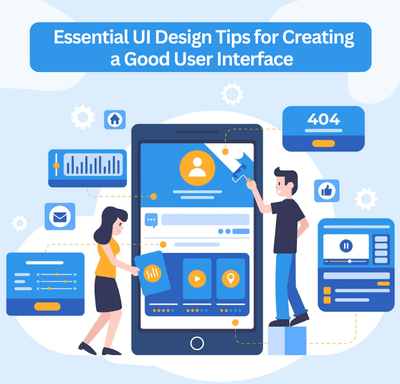
About us
Our Services
Our Expertise
Our Experience
Follow us
Why e2logy?
- We strive to provide superior customer service and ensure that every client is completely satisfied with our work.
- Our engineers are trustworthy, dedicated, and experienced and will go the extra mile to solve your IT issues.
- We are committed to delivering outstanding, cutting-edge IT solutions that add real value that goes beyond what is expected.

Essential UI Design Tips for Creating a Good User Interface

Links between pages do not make up a website. The interface facilitates the exchange of information and affects the impact of different things – in this case, the interactions between a company’s or individual’s web presence and a person’s web presence. Your job as a web designer is to ensure the visitor gets the best possible experience from that interaction.
Keeping your user at the forefront of your mind is key to this strategy.
A user experience design is a subset of interface design, which focuses on the bigger picture of the whole experience. In other words, interface design is concerned with how interfaces function.
What makes UI design user-friendly?
It takes cognitive effort to use a website or app. Using a product requires effort on the user’s part – the more effort they put in, the less satisfied they will be.
User-friendly interface elements make tasks easier to complete, reducing the amount of time and effort required by the user. Good UI design facilitates smooth interface interactions, resulting in a positive user experience. The use of user-friendly interfaces reduces friction points and improves overall satisfaction with the interface.
Essential UI Design Tips for Creating a Good User Interface
We’ve compiled a small, and easy-to-implement, selection of tips to help you improve your designs, not just today, but as well as for future projects when you begin them.
1. Design for the right audience
Often, UX designers are responsible for tasks like user research, wireframing, testing, and information architecture design, but increasingly, UX/UI designers are combining their skills. The UI designer can make interaction, colour and type choices that are influenced by the people using the product or service. This is when he or she gets involved in the creation of, or at least pays attention to, the personas, wireframes, and information architecture developed in the UX workstream. Designing interfaces that are both visually and functionally pleasing to users can be achieved by taking the time to understand the users they are designing for.
2. Enhance the definition of your elements
If you wish to make certain elements appear a little sharper, more defined, and help avoid those muddy shadows, you can use multiple drop shadows, or a very subtle border (just a shade darker than the shadow itself).
3. Consistency is key
Consistency in feature placement within your UI is crucial, as we discussed just a moment ago. UI must also work smoothly across the entire product and look consistent. Do not have the menu at the top and bottom of the same page. Whenever the menu loads, don’t rearrange the items. User-friendly navigation on your site is crucial. Do not decide to turn off your contact form if you keep one below your blog posts. This will be noticed by users and they will be confused by it.
It is also important to have consistent fonts and designs throughout your site. Changing the font on a page shouldn’t be done.
If something makes your user surprised, rework it so it’s more intuitive by using the principle of least surprise.
The UI of an iOS application is different from that of an Android app, for example, you must keep that in mind when designing your UI. Menus, galleries, and even product checkouts on desktop sites are different from those on mobile sites. It’s important to keep your site consistent to avoid frustrating your users.
4. An easy-to-navigate area
It is crucial to usability to have a good navigation system. Content items and features can be located using this tool. Navigation needs to reflect the category hierarchy in conjunction with the content structure. This will lead to confusion and frustration on the part of the user.
It is also important to make the navigation areas as visible and prominent as possible on all devices, including desktops and mobiles. User transitions between content would be faster as a result. Using primary navigation elements for important categories and secondary menus for the rest of the content when you have a complex mobile content structure is a good way to handle complex content structures.
5. Information should be arranged and prioritized
There is a hierarchical structure to the content on every website or app. It is logical to categorize and subcategorize all topics. Users should be familiar with these categories and know what to expect from them. It is easier for users to navigate and find important information with a structure that makes sense to them.
As well as different categories, users have different priorities. In a news app, breaking news would appear first and sports news last, similar to how it appears on TV. Especially on mobile screens, you must place important content above all other content in your content structure.
6. Provide feedback
Our real world experience is that we always receive feedback on many occasions for many different things, but in the digital world, we tend to get a lot of feedback. As a result, we were left unsure whether it would be better to try again, go back, shut down the browser, or just restart our computer or laptop.
Make sure the window cannot be closed by the user. Animate the loading process for them. A slight pop is added to the button upon click, and it snaps back into place. An interactive high-five can be sent to users when they’re done with a task.
Web pages should be loaded in under 5 seconds, but if there is a delay, then pinwheels or animations should be used. The page loads faster when such visuals are implemented.
7. Keep standards in mind
The structure and layout of UI design have remained the same for decades. Consequently, users can confidently navigate digital landscapes worldwide because of familiarity.
Maintaining a basic structure doesn’t seem difficult. The best idea isn’t always to reinvent things, but designers tend to love to do so.
Consider if your persona would have any difficulty interacting with your design to avoid breaking user interface standards. It would be useful to ask the end users for feedback along the way. This could (should) be taken one step further.
8. Real-world testing of your UI design
In addition to validating your hypotheses about the user’s needs, user research also helps you generate new hypotheses. Testing your solutions with users validates them. Your design can only be evaluated if it solves the problem specified.
Before deploying any new design, ensure that it is tested with real people. Try out high-fidelity prototypes that people can complete online and share with others. Take note of their interaction with the interface. Make sure you are aware of friction points, hesitations, and dropouts. You should revisit your design in light of the test results once you have conclusive results.
Final Words
It is essential to know a great deal about user experience design and user psychology to design user interfaces. To ensure that your UIs perform to their full potential, you should follow the best practices in the field. You can turn your design into deployable code using tools for real-time code generation when building UIs. The incredible thing about E2logy is that it allows quick drag-and-drop UI creation without requiring coding.













